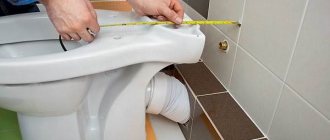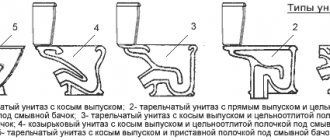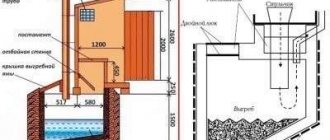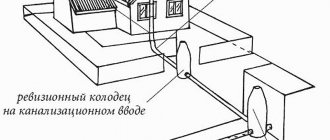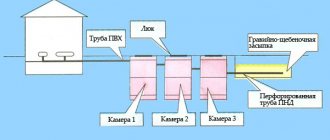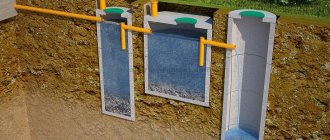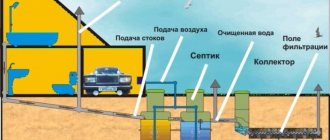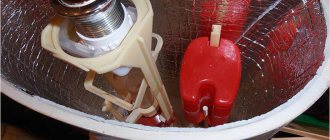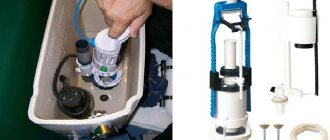The old-style toilet cistern has long been discontinued, but, nevertheless, it can be found in houses and apartments throughout the country, which indicates the fairly reliable operation of such systems and their durability.
In the photo: most often old tanks are located near the ceiling
In this article we will look at the main differences between the old and new options and tell you how to fix the most common breakdowns and malfunctions with your own hands, especially since the work is very simple and does not require the use of special tools and devices.
Features of old systems
The so-called “Soviet” modifications have a number of differences from modern versions; let’s consider the most significant of them:
| Unattractive appearance | Several decades ago, little care was taken about external attractiveness; the main attention was paid to the practical side: the reliability of each unit, its performance. Therefore, old tanks do not look very aesthetically pleasing: primitive shape, rough surface |
| Tank location | In the vast majority of cases, the container is located under the ceiling, and the water flows through a riser pipe. This allows the water flow to gain high speed and provide high-quality flushing, but this is accompanied by noise; compact options can also be found, but they are quite rare |
| Design features of shut-off valves | The flushing system in such products is very unique and is based on the principle of a rocker arm, when you need to pull a chain or rope. The device of the old-style toilet cistern is simple; no assembly instructions are required - everything is clear even to those who see such a system for the first time |
| High water consumption | Previously, no one was worried about the issue of water consumption, so in such designs there are no economical drainage modes; the system always drains the entire volume, which, you see, is not very convenient and impractical |
| Intake system | In all old models, water is supplied exclusively from the side, other options were simply not used, this is both a plus, because everything is unified, and a minus - because the hoses cannot be hidden in any way, and they will always be in sight |
Draining of water is always done using a handle on a chain
Advice! Sometimes it is much easier to replace the tank with a more modern one than to repair it. The decision is made on a case-by-case basis - if the extent of damage to the elements is large, then repairing them may take too much time and money.
Soviet era toilet design
Not many of our compatriots are in a hurry to change the good old, and most importantly, durable, Soviet-made design for a modern ceramic model that does not inspire confidence.
Characteristic features of a Soviet-style toilet:
- manufacturing materials: cast iron or earthenware;
- the drain lever is located on the left or in the center of the product;
- water supply is exclusively lateral.
As for the aesthetic part, we can say this without comment. Indeed, at that time they did not particularly care about beauty; the toilet played an exclusively practical role.
Shut-off valves, presented in the form of a drain mechanism and a kind of automatic machine, were responsible for supplying water to such a tank. And the drainage of water was even more interesting: a wide outlet siphon, covered with a plastic or rubber valve, the mechanism in appearance resembles a plunger.
Toilet cistern design
Water is drained using a rod, which can be attached to the side lever or brought out to the central part of the lid.
The shut-off valve with a push button is connected by means of a lever to a plastic float, which moves in a vertical plane throughout the entire tank capacity.
When the internal volume of the tank is filled with water, the float rises and the lever rotates, thereby increasing the pressure on the intake valve stem. As soon as the degree of pressure on the rod equals the water pressure, the valve closes. In this case, the toilet cistern of the previous model is ready for use.
The advantage of a Soviet-style toilet cistern is the absence of many small parts and springs. This feature allows even a home plumber to adjust or repair shut-off valves.
Replacing broken parts is quite easy
Perhaps now such a mechanism seems primitive and outdated to you, but its quality and reliability exceeds any indicators of modern models.
Disadvantage of an outdated toilet: due to design features and softer requirements for water flow, shut-off valves cannot be replaced with a new mechanism. All you have to do is try to repair the device so that the fittings do not let water through and do not waste it in vain.
There is always a drastic way out - this is buying a new toilet with a modern cistern model, which is less troublesome and simple, but expensive.
The modern plumbing market is rich in various models that satisfy our high aesthetic and practical needs. Of course, the toilet of the previous model is practical and reliable like no other, but today such products are no longer produced, and the models installed in our homes are becoming obsolete.
Toilet design for a better understanding of the problem
Gradually, old toilets begin to fail: they do not fill with water, drain too much water, lose their appearance and turn yellow. All you have to do is choose what you can do: study materials for repairing an old toilet or save up for a new model.
Design differences and typical malfunctions
Let's consider how the old versions differed from the modern ones, especially since the difference is fundamental and significantly affects the operation of the system.
Device
To figure out how to repair an old-style toilet cistern, you need to know the main features of its structure and the principles on which the operation of the entire system is based:
- The material used to make the body is earthenware (less often) and cast iron (much more often). The use of a metal container involves corrosion processes on the surface, so the tank must be periodically tinted on the outside and cleaned from the inside, otherwise rust particles may clog some elements, causing breakdown.
Cast iron is not the best option for a tank; at one time it was used because the price was low
- The release lever is located either on the left or in the front, the water supply is most often on the right side . To ensure uninterrupted operation and avoid leaks, it is best to immediately replace the liner - modern flexible options cost little and last a very long time.
- The tank is connected to the toilet by a steel pipe, the length of which can vary . Many developers reduce its length to improve aesthetic appeal; this option looks much better.
This is what the system looks like in old tanks - everything is quite simple, which ensures reliability and durability
- The system works on the principle of a rocker: when you pull the chain, the cast iron bell rises and releases water; when the handle is released, the system closes under its own weight . The water level is controlled by a float connected through a rod to the inlet valve - the system is simple, and therefore reliable and efficient, a minimum of parts ensures its long service life.
The old-style compact toilet cistern has design differences, but the operating principle is largely similar: a minimum of parts and a maximum of simplicity
Features of repair work
As a rule, the nature of failures in the devices of the group under consideration is typical, so we will consider the most common malfunctions and ways to eliminate them:
- Every few years, the soft rubber gasket installed on the outlet becomes unusable or simply breaks, causing water to constantly flow into the toilet. The solution to the problem is simple: replacing the sealing element, and you can cut it out of rubber yourself to the size of the old worn element.
The weight of the bell over time pushes the rubber ring, which is why a leak occurs.
- The overflow, which is made of cast iron in the shape of a bell, over several decades of operation becomes covered with a layer of rust and other deposits, due to which the flushing efficiency is noticeably reduced.
Tip: The problem is solved quite simply: the element is removed, burned on fire and tapped with a hammer, after which the overflow is installed in place, and it is better to change all the sealing elements at the same time.
- The constant outflow of water through the drainage channel is caused by damage to the float. In this case, finding a replacement can be quite difficult, so the float must be soldered or sealed to restore integrity. Sometimes violations of this kind are caused by the fact that the rod is bent; it can be straightened and the system will work better.
The floats in old tanks are quite massive
- If you want to figure out how to repair an old-style toilet cistern, in which the system has stopped working due to broken connections, then you must understand that many connections are made in the form of rigid wire couplings; they are the ones that can break or come loose. You can easily do them yourself, restoring the system’s functionality in a few minutes.
- And finally, with prolonged use, the water inlet system may become clogged (especially if it is rusty). In this case, the intake unit needs to be cleaned; most often this is enough to restore functionality.
What parts does the structure consist of?
First, let's figure out which components are responsible for the operation of the system and what functions they perform:
| filling valve | The main function of this unit is to fill the tank to a certain level. That is, the mechanism ensures the supply of water after flushing in the amount that is necessary. There are many options for such units, but in all of them the main working element is the float, which is the main regulating element |
| Drain mechanism | This part of the system is designed to ensure that the water supply opens after a button is pressed or a lever is turned. There are many options for implementing the system; below we will consider the most popular solutions today |
| Overflow valve | It is also an important element of any design, which is responsible for ensuring that if the water level in the tank is too high, it goes into the toilet and does not spill throughout the room. Most often, this unit is combined with a filling valve, which simplifies maintenance and repair. |
Important! Do not rush to purchase spare parts before starting work; first of all, you need to open the lid and figure out which version of the system you are using. After this, a decision is made whether to repair the existing parts or replace them with new ones.
Conclusion
In fact, repairing an old-style toilet cistern is much easier than repairing modern options. This is due to the simplicity of the system and the reliability of all components included in it (see also the article “Valve for the drain tank - types and repair methods”).
The video in this article will clearly show some of the features of the work.
Did you like the article? Subscribe to our Yandex.Zen channel
How to replace a toilet: dismantling the old one and installing a new one with your own hands
Properly installed plumbing fixtures can last for years. However, everything has a certain service life and the time comes when it becomes clear that replacing the toilet is inevitable. For many, this procedure does not cause much trouble: you just need to call one of several dozen companies providing plumbing services, and the specialists will carry out all the work in a matter of hours. However, for a number of reasons this may not be possible and then the equipment will have to be changed independently.
What do you need to prepare before work?
First of all, you should buy a new toilet. To do this, you need to understand the design and dimensions of the old one. We measure the room in detail and make a simple drawing on which we indicate the installed toilet and the sewer and water pipes connected to it. Checking the angle of the waste neck. As a rule, it is 45°, but it is better to double-check this. If such work is to be carried out for the first time, and there is very little experience, you can take a photo of the structure with your phone before going to the store in order to consult with the seller about the type of new device.
It will be much easier to choose a new toilet based on the drawing and photo. We pay attention to the dimensions of the device, shape and design features. On sale you can find devices with different depths and bowl shapes, drain hole slopes and flush designs. Let's not forget about design. Among the various shades and materials, you should choose the best option for your room. With other identical parameters of the device, it is worth giving preference to equipment from well-known companies that produce higher quality products.
How to install an autonomous tank
Installing an autonomous water tank on the wall is more difficult than mounting a storage tank on a toilet shelf; it is advisable to do this work together.
The installation process proceeds as follows:
- Two marks are made on the surface of the wall in the places where the container will be attached. You should not lift the autonomous tank high, as it will be inconvenient to use. In addition, it is important to check in advance that the length of the overflow tube is sufficient from the container to the toilet; the two marks made are checked by level so that the container is positioned strictly horizontally;
- in the marked places, holes are drilled with a hammer drill; their diameter must correspond to the diameter of the dowels being inserted;
- a drain fitting is placed inside the storage tank, after which an overflow tube is connected; it is important to connect it through gaskets that seal the equipment;
- the container is secured to the wall using bolts or dowels, which are screwed into the drilled holes;
- the overflow tube is connected to the toilet;
- A flexible water pipe is connected to the autonomous drive through gaskets.
After assembling this equipment and connecting it, testing begins. If a leak occurs, turn off the water supply and repair the leak.

